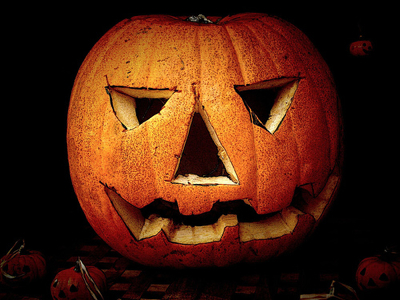
With Halloween approaching, this weekend will
likely see children across the country dressing up and going out
trick or treating. Whilst many bemoan this 'Americanisation' of a
traditional celebration, the current trends for celebrating Halloween
are not far removed from centuries old British (Celtic and Gaelic)
tradition.
The original Hallows Eve festivities marked the end of the harvest season and the start of the 'darker half' of the year. It was seen as a time when spirits and fairies could more easily move into our world and were especially active.
In the English Hallowmas celebrations, households
often put candles burning in the windows of every room to guide the
souls back to visit their earthly homes. Spirits were welcomed back
into their former houses, feasts were had to which the souls of
departed kin were beckoned and places were set for them at the table.
However, some spirits and fairies could cause harm and needed to be
warded off. Bonfires were considered to be protective and cleansing,
and this may be an additional origin of our modern day bonfire
festivals.
By the end of the 12th century is was
customary for criers to parade the streets dressed in black, ringing
a bell and calling for good Christians to remember the souls of the
dead.
In Ireland, Scotland, Wales and the Isle of Mann
'mumming and guising' was a Halloween celebration, the latter of
which goes back at least to the 18th century. In this
celebration people went from house to house in costume or disguise,
reciting songs in exchange for food. Souling was the tradition of baking and sharing 'soul cakes' for all christened souls and this has been suggested as the origin of trick or treating. Possibly originating in Celtic
tradition, costumes were a means of imitating or disguising oneself
from spirits and fairies. The traditional belief was that the dead
wandered the earth until All Saints Day, and All Hallows Eve provided
their last chance to gain vengeance on their living enemies, before
moving on to the next life. Donning masks and costumes was a way for
people to disguise their identities from any souls seeking them out.
During these celebrations people would also carry
lamps, or Jack 'o' lanterns, often carved from turnips or potatoes.
Grotesque faces would be carved into them to represent or repel evil
spirits and goblins. In later centuries immigrants to America found
that the native pumpkin made a far better lantern, and the current
tradition began.

Halloween recipes often focus on pumpkins, but, as
we have mentioned traditional Halloween cakes in this blog, we should
look at these. In England 'soul cakes' were small, round cakes,
filled with allspice, cinnamon, nutmeg and ginger with raisins and
currents. Very much like present day hot cross buns they were marked
on the top with a cross.
 |

Barmbrack loaf and English Soul Cakes.
In Ireland the traditional Halloween cake is
Barmbrack, again a fruit loaf with sweet spices. The Halloween brack
traditionally contained various items such as, a ring, a coin, a
piece of cloth, a stick and a pea. When the cake was divided up each
recipient would have an item in their slice. Each item represented
meaning to the person receiving them, usually concerning their
marriage prospects or fortune.


No comments:
Post a Comment